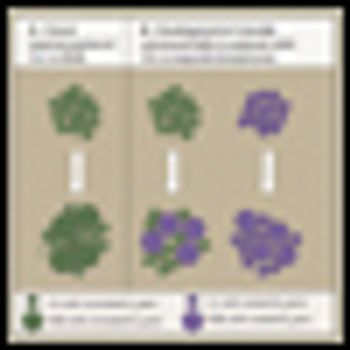
This video examines frontline treatment options for patients with newly diagnosed chronic lymphocytic leukemia, including considerations for when chemotherapy or ibrutinib might be more appropriate.

Your AI-Trained Oncology Knowledge Connection!


This video examines frontline treatment options for patients with newly diagnosed chronic lymphocytic leukemia, including considerations for when chemotherapy or ibrutinib might be more appropriate.

Richter's transformation, or Richter's syndrome, is an uncommon clinicopathological condition observed in about 5% to 10% of patients with chronic lymphocytic leukemia (CLL). This review summarizes advances in our understanding of the pathobiology and in the management of Richter's transformation in patients with CLL.

One strategy would be to consider “early treatment” for patients with deletion 17p, with the goal being to delay disease progression. This strategy is currently being explored in several prospective clinical trials employing treatment regimens such as FCR, lenalidomide (Revlimid), alemtuzumab (Campath), ofatumumab (Arzerra), and others.

Our ability to stratify patients with CLL into high-risk and low-risk categories has advanced dramatically over the past two decades. However, which test or tests are most reliable remains to be seen.

ONCOLOGY talks with Dr. Susan O’Brien, professor in the department of leukemia at the MD Anderson Cancer Center. Dr. O’Brien will be one of the presenters at the upcoming ASCO session on therapies for chronic lymphocytic leukemia, and she gives us a preview of what some of the highlights of the session are likely to be, as well as some insights into her own work.

Chronic lymphocytic leukemia (CLL) is the most common adult leukemia in the Western hemisphere, accounting for 30% of the leukemias in this population. The disease results from a clonal expansion of small B-lymphocytes. CLL always involves the bone marrow and peripheral blood. The disease also can be demonstrated in lymph nodes, liver, and spleen.

Chronic lymphocytic leukemia (CLL) is a clonal malignancy that results fromexpansion of the mature lymphocyte compartment. This expansion is aconsequence of prolonged cell survival, despite a low proliferative index. Theaffected lymphocytes are of B-cell lineage in 95% of cases, and the remainingcases involve T lymphocytes, likely representing a distinct disorder.

Dr. Nabhan and his coauthorshave written a comprehensivereview of the use of monoclonalantibodies in the treatment ofchronic lymphocytic leukemia (CLL).They have highlighted importantclinical trials with newer antibodies,including apolizumab (Hu1D10,Remitogen) and IDEC-152 (anti-CD23). The authors concisely describethe use of rituximab (Rituxan)and alemtuzumab (Campath) as singleagents and in combination therapy.Both antibodies have efficacy inthe treatment of CLL, but both havelimitations when used as singleagents.

Currently, patients with early-stage chronic lymphocytic leukemia (CLL) without active disease are observed. However, those patients with elevated beta-2-microglobulin levels appear to have a shorter median survival (6 years vs 10+ years).

Front-line treatment of chronic lymphocytic leukemia (CLL) with single-agent fludarabine (Fludara) achieves complete remission in 35% of patients.

Wild-type bcl-2 protein is normally found within the bilaminar membrane of the mitochondrion, where it is believed to negatively regulate the release of cytochrome C into the cytoplasm after an apoptotic signal has triggered dimerization of bax protein.

In this report, we present our results of the biochemotherapy combination of rituximab (Rituxan), a monoclonal antibody against CD20, with fludarabine (Fludara) and cyclophosphamide (Cytoxan, Neosar).

Monoclonal antibodies demonstrate impressive response rates in lymphoid diseases, and treatment indications are expanding. Both alemtuzumab (Campath) (anti-CD52) and rituximab (Rituxan) (anti-CD20) are active in chronic lymphocytic leukemia (CLL) and low-grade lymphomas.

Treatment options for patients with relapsed chronic lymphocytic leukemia (CLL) are limited. In this report, we present our preliminary results of a biochemotherapy combination using rituximab (Rituxan, a monoclonal antibody against CD20) with

Initial treatment of chronic lymphocytic leukemia (CLL) with fludarabine (Fludara) or fludarabine/cyclophosphamide (Cytoxan, Neosar) resulted in complete remission (CR) rates of 28% and 35%, respectively. Recently, rituximab (Rituxan)

Over the past 2 decades, our understanding of the pathobiological events underlying chronic myelogenous leukemia (CML) has grown. At the same time, effective transplant and nontransplant treatment approaches to

Managing the infectious complications associated with pentostatin (Nipent), used alone or in combination with other agents in patients with low-grade lymphomas, poses a significant problem for clinicians. Since there is limited

Rituximab (Rituxan) is a chimeric monoclonal antibody binding to CD20. A multicenter trial in relapsed low-grade lymphoma (375 mg/m²/wk × 4) produced a response rate of 48%. However, patients with small lymphocytic lymphoma

Treatment of recurrent or nucleoside analog–refractory hairy cell leukemia (HCL) may be limited by poor tolerance (eg, interferon), profound CD4 lymphopenia, or comorbid conditions in which prolonged myelosuppression from nucleoside analog

Published: March 1st 2002 | Updated:

Published: March 1st 2000 | Updated:

Published: March 1st 2001 | Updated:

Published: March 1st 2002 | Updated:

Published: March 1st 2000 | Updated: